- Bush Hog vs Brush Hog
- What is a Bush Hog?
- What is a Brush Hog?
- Difference Between Rotary Mower & Brush Hog (Rotary Cutter)
- Top 10 Brush Hog Rotary Cutter Manufacturers
- Flail Mower vs Finish Mower vs Bush/Brush Hog
- Which Tractors Are Ideal for Bush Hogging?
- How Much Should Bush Hogging Cost?
- Bush Hog Pricing Per Acre
- Bush Hog Pricing Per Hour
- Factors Influencing Bush Hogging Cost
Bush hogging, also known as brush hogging, is a method of land clearing and vegetation management commonly used in agricultural and rural settings. It involves the use of a bush hog, which is a type of rotary cutter or mower, to cut down thick brush, tall grass, weeds, and small trees.
The process typically involves attaching the bush hog to a tractor and driving it over the area to be cleared. The rotating blades of the bush hog are powered by the tractor’s engine and are designed to cut through dense vegetation with ease. Bush hogging is particularly useful for clearing overgrown fields, pastures, road edges, fence lines, and other areas where vegetation has become too dense or overgrown.
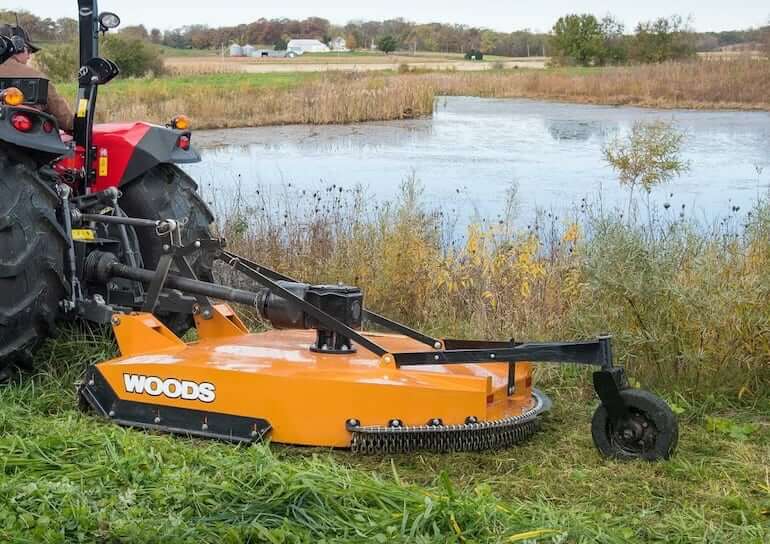
Bush hogging is an effective method for land maintenance and can help improve visibility, access, and overall aesthetics of the property. It is often used by farmers, ranchers, landowners, and land management professionals to keep their properties well-maintained and free from excessive vegetation.
Bush Hog vs Brush Hog
The key difference between a brush hog and a bush hog is the purpose of the device. A brush hog is designed to trim back the sides of trees and bushes, such as trimming low hanging branches of trees that grow over roads. A bush hog, on the other hand, is used to clear land from brush, small bushes, tall grass, and other overgrown vegetation.
What is a Bush Hog?
A bush hog is a brand name for a specific type of brush hog, made by Bush Hog, Inc. of Selma, Alabama. It is a type of rotary mower that is synonymous with the process of clearing land from brush, small bushes, tall grass, and other overgrown vegetation.
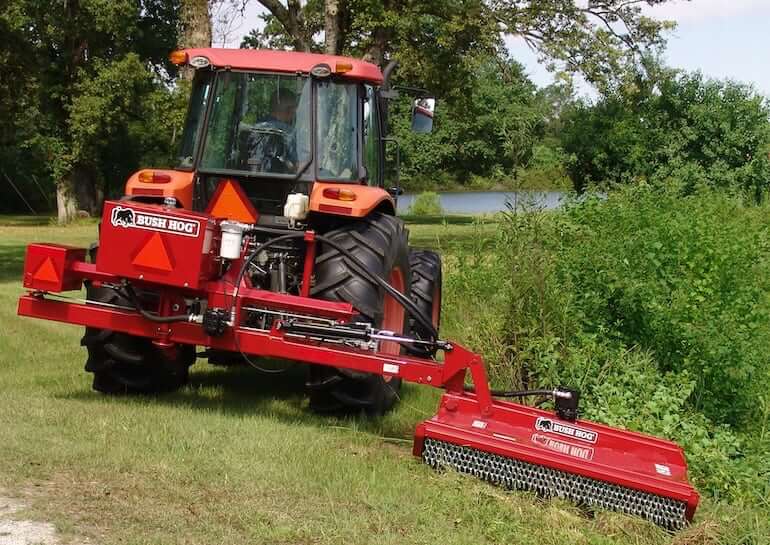
The unit is typically pulled by a tractor, although some are standalone machinery. The process of bush hogging involves using a bush hog to clear off a piece of land that has been overgrown due to lack of maintenance or other reasons.
What is a Brush Hog?
A brush hog, also known as a rotary cutter, is a type of mower designed to cut through thick vegetation, including vines, small bushes, and other overgrown vegetation. It is typically attached to the back of a farm tractor using the three-point hitch and is driven via the power take-off (PTO).
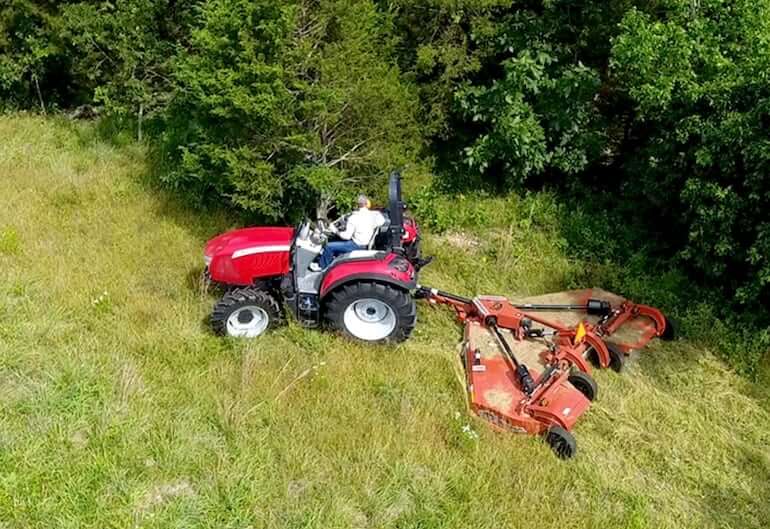
The blades are not rigidly attached to the drive like a lawnmower blade, but are on hinges, allowing them to bounce backward and inward if they hit a rock or stump, and then centrifugal force makes them go outwards again. The rotary blades are usually quite dull, so they whack through dense plant growth, whereas a sharp blade often gets stuck or slowed.
Difference Between Rotary Mower & Brush Hog (Rotary Cutter)
The main difference between a rotary mower and a brush hog lies in their design and purpose:
- Rotary Mower: A rotary mower is a type of mower designed for cutting grass and other vegetation with a sharp blade that is rigidly attached to the drive. It is typically used for maintaining lawns and areas where appearance and neatness are important.
- Brush Hog (or Rotary Cutter): A brush hog, also known as a rotary cutter, is specifically designed to cut through thick vegetation like small trees, bushes, and saplings. It is commonly attached to the back of a farm tractor using the three-point hitch and is driven via the power take-off (PTO). Unlike a traditional mower blade, the blades of a brush hog are not rigidly attached to the drive but are on hinges, allowing them to bounce backward and inward if they hit obstacles like rocks or stumps. The blades are usually dull and heavy, enabling them to cut through dense plant growth effectively.
In summary, while a rotary mower is intended for regular grass cutting and maintaining lawns, a brush hog (or rotary cutter) is specifically designed for cutting through thick vegetation and overgrown areas, making it more suitable for heavy-duty land clearing tasks.
Top 10 Brush Hog Rotary Cutter Manufacturers
These are some of the manufacturers of brush hog rotary cutters:
| Manufacturer | Description |
|---|---|
| Bush Hog, Inc. | Leading North American manufacturer of rotary cutters, finishing mowers, landscape tools, and tractor-mounted implements. Known for ruggedness and durability in challenging work environments. |
| RhinoAg | Manufacturer of Flex-Wing rotary cutters and flail shredders. |
| Dirt Dog | Manufacturer of standard duty rotary cutters designed for light to heavy grass conditions and cutting light brush up to 1-1/2 inches in diameter. |
| Land Pride | Manufacturer of rotary cutters for various tractor sizes and applications. |
| Brush Wolf | Brush cutters designed for industrial, commercial, or forestry use. Heavy-duty rotary cutters for compact utility loaders, skid steers, excavators or backhoes, site prep tractors. |
| Woods Equipment | Manufacturer of rotary cutters for agricultural and land management purposes. |
| Bush-Whacker | Flex-wing cutters, single-spindle cutters, heavy-duty dual-spindle cutters, boom cutters, skid steer mounted brush mowers |
| Hardee by EVH Manufacturing Co. | Manufacturer of rotary cutters and tractor-mounted implements. |
| DR Power Equipment | Manufacturer of rotary cutters, brush mowers and 3-point hitch trimmer mowers. |
| King Kutter | Manufacturer of rotary cutters and finishing mowers for agricultural use. |
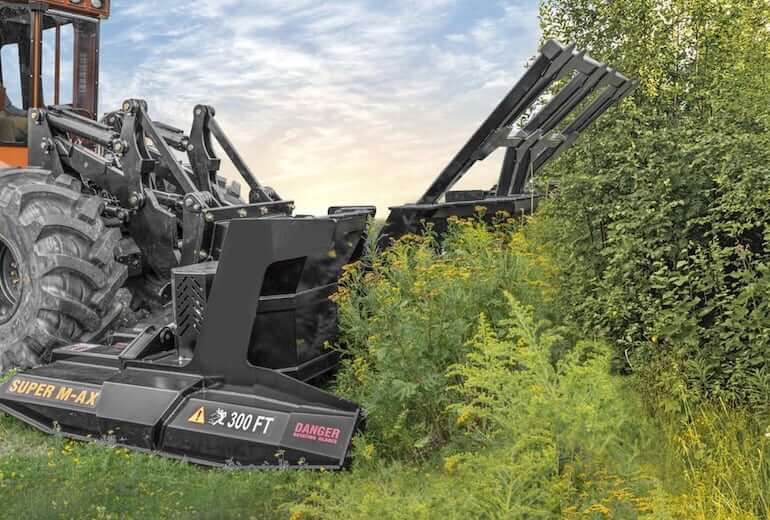
A brush hog is a type of rotary mower designed to cut through thick vegetation, while a bush hog is a specific brand name for a type of brush hog used for clearing land from overgrown vegetation.
The terms are often used interchangeably, but the brush hog is a generic term for a mower that is not a finish mower, whereas the bush hog is a brand name.
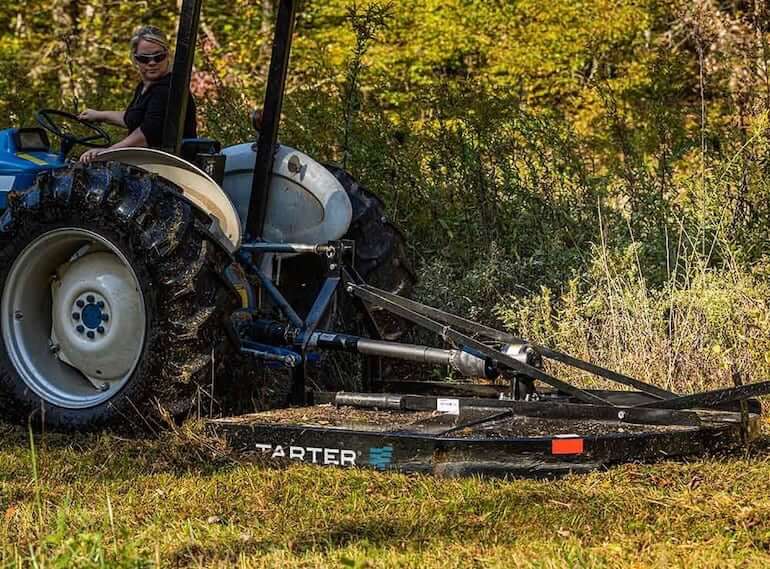
“Bush hogging” refers to the process of using a brush hog or rotary cutter to clear overgrown land and vegetation, which is a common task in agricultural, landscaping, and land management applications.
Flail Mower vs Finish Mower vs Bush/Brush Hog
The comparison between a Flail Mower, Finish Mower, and Bush Hog:
Flail Mower – a PTO-powered flail mower is designed with rows of small, independently pivoting blades attached to a rotating drum. These blades swing outward and strike the vegetation at high speed, cutting it down. Flail mowers are versatile and can handle rough terrain, grass, weeds, thick brush, and even small trees. They are commonly used for clearing overgrown areas, roadside maintenance, and shredding vegetation.
- Cutting Quality: Offers superior cutting quality, leaving a clean and even finish.
- Cutting Capacity: Handles tall grass and light brush effectively.
- Safety: Generally safer due to enclosed knives, reducing the risk of flying debris.
- Maintenance: Easier to maintain with fewer moving parts.
- Cost: More expensive but versatile.
- Best For: Those needing a versatile implement for various vegetation types with superior cutting quality.
Finish Mower – known for low horsepower requirements and ideal for regular mowing. A finish mower is equipped with multiple blades mounted on a rotating deck. These blades are usually positioned horizontally and provide a clean, manicured cut. Finish mowers are designed for mowing large areas of grass where a fine, uniform finish is desired. They are commonly used for maintaining lawns, parks, sports fields, and golf courses.
- Cutting Quality: Provides a neat finish but struggles with woody plants and tall grass.
- Cutting Capacity: Limited compared to flail mowers and brush hogs.
- Safety: Generally safe for regular mowing tasks.
- Maintenance: Requires less maintenance compared to other options.
- Cost: Affordable but more specialized for specific mowing tasks.
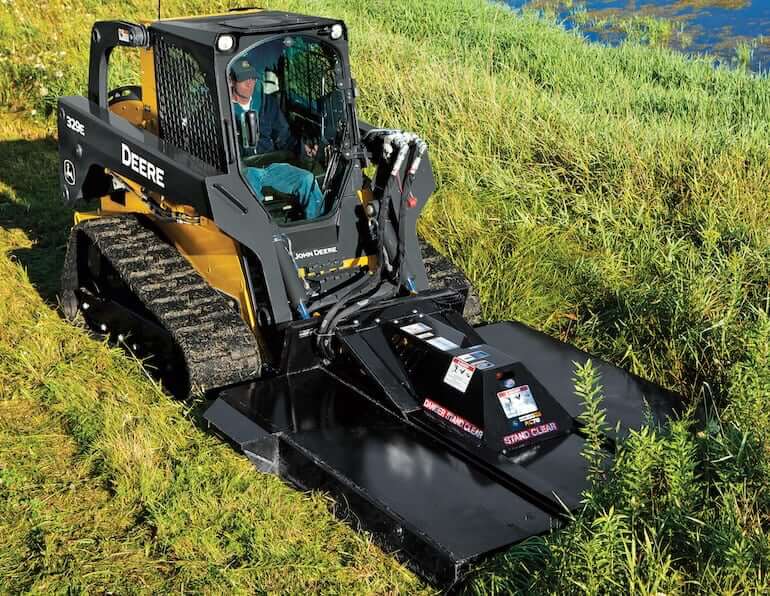
Bush Hog (Brush Hog) – a bush hog, also known as a rotary cutter, features a heavy-duty, horizontally rotating blade attached to a gearbox and frame. The blade spins at high speed, cutting through vegetation. Bush hogs are designed for heavy-duty cutting tasks, such as clearing fields, pastures, and rough terrain. They excel at cutting thick brush, tall grass, small trees, bushes, and saplings, making them ideal for agricultural and land management applications.
- Cutting Quality: Can leave uneven cut patterns but excels at cutting through thick vegetation.
- Cutting Capacity: Ideal for clearing large areas of land with overgrown vegetation.
- Safety: Can kick up rocks and debris, posing potential dangers.
- Maintenance: Requires frequent blade sharpening due to the single blade design.
- Cost: More affordable compared to flail mowers but less versatile.
The choice between a Flail Mower, Finish Mower, and Bush Hog depends on factors like cutting quality, cutting capacity, safety, maintenance, and cost, with each option offering unique advantages and disadvantages tailored to specific land maintenance needs:
- Flail mowers are versatile and can handle rough terrain and thick vegetation.
- Finish mowers provide a clean, manicured cut and are suitable for maintaining lawns and similar areas.
- Brush / bush hogs (rotary cutters) are heavy-duty machines designed for clearing dense vegetation and rough terrain in agricultural and land management settings.
Which Tractors Are Ideal for Bush Hogging?
Tractors ideal for bush hogging typically have certain characteristics to effectively handle the demands of this task:
- Engine Power: Brush hogging often involves cutting through dense vegetation, so a tractor with sufficient horsepower is necessary to provide the torque needed to drive the brush hog through thick brush and rough terrain.
- Weight and Stability: Bush hogging can be rough and uneven, so a heavier tractor provides better stability and traction, especially on sloped or uneven terrain. This helps prevent tipping and ensures safe operation.
- Hydraulic Capacity: Tractors equipped with sufficient hydraulic capacity can power larger and heavier brush hogs, allowing for more efficient cutting and better control over the equipment.
- Tire Configuration: Tractors with sturdy, aggressive tread tires or specialized flotation tires provide better traction and maneuverability in challenging conditions encountered during brush hogging.
- Durability and Protection: Since bush hogging involves cutting through potentially damaging debris like rocks, stumps, and branches, a tractor with reinforced construction and protective features, such as skid plates and debris deflectors, can help prevent damage to the tractor and its components.
- Attachment Compatibility: The tractor should be compatible with a wide range of brush hog attachments in terms of hitch type, PTO power output, and hydraulic connections.
Popular tractor brands known for their suitability for brush hogging include John Deere, Kubota, Massey Ferguson, New Holland, and Case IH.
Models within these brands, such as the John Deere 5 Series, Kubota L Series, and Massey Ferguson 4700 Series, often offer features and capabilities well-suited for bush hogging applications.
How Much Should Bush Hogging Cost?
The cost of bush hogging varies based on several factors, including the size of the area, vegetation density, terrain complexity, and regional market conditions.
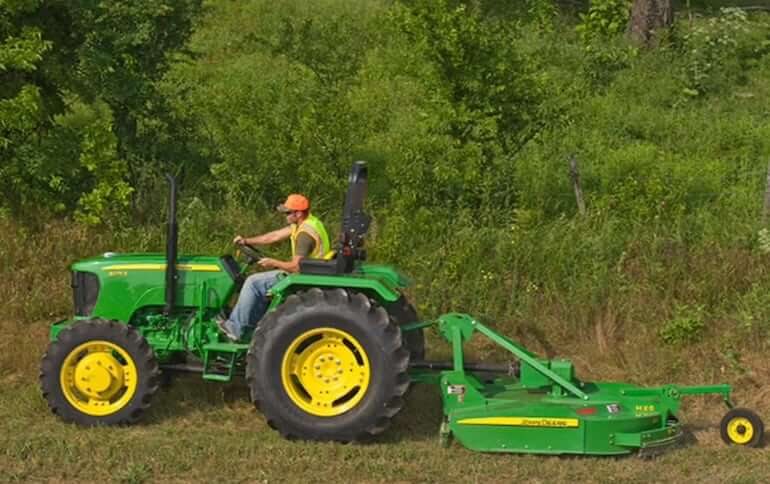
Bush Hog Pricing Per Acre
- Basic Bush Hogging: For relatively flat land with light to moderate vegetation, rates typically range from $50 to $150 per acre.
- Moderate to Dense Vegetation: Areas with uneven terrain or denser brush may incur costs between $25 to $40 per acre.
- Heavy Brush or Challenging Terrain: Land characterized by steep slopes, thick brush, or small trees can see rates from $40 to $75 or more per acre.
Bush Hog Pricing Per Hour
Some service providers opt for hourly rates, which can vary based on the job’s complexity:
- Basic Bush Hogging: Involves clearing dense overgrown grass and light shrubbery, typically costing around $70 per hour.
- Brush Hogging: Deals with dense grass, shrubs, and saplings up to 2 inches thick, with rates averaging $80 per hour.
- Light Land Clearing: Encompasses the removal of most vegetation except mature trees, costing approximately $120 per hour.
- Heavy Land Clearing: Involves clearing all vegetation, including mature trees, with rates ranging from $200 to $350 or more per hour.
Factors Influencing Bush Hogging Cost
Several elements can affect bush hogging rates:
- Vegetation Density and Type: Denser brush and tougher vegetation require more effort and time to clear.
- Terrain Complexity: Uneven or hilly terrains pose challenges that can increase costs.
- Land Size: Larger areas might benefit from reduced per-acre rates due to economies of scale.
- Accessibility: Difficult-to-access areas may lead to higher charges due to increased time and equipment maneuvering.
- Regional Market Conditions: Local demand and operating costs can influence pricing structures.
Geographical location plays a significant role in determining costs. For instance, in Central Florida, estimates are:
- 1 Acre: Approximately $200 to $300+, depending on terrain and vegetation density.
- 5 Acres: Between $300 and $750+, with variations based on accessibility and complexity.
- 10 Acres: Ranging from $600 to $1,500+, reflecting the increased scope of the job.
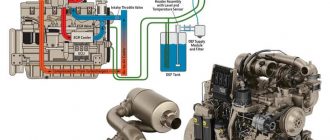
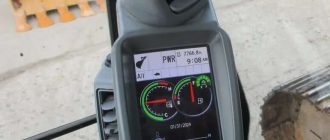
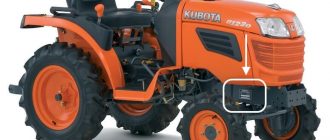
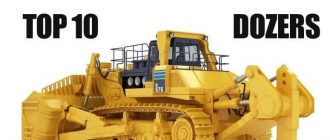
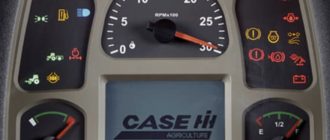
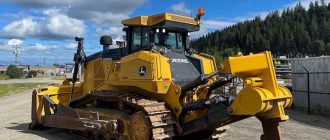
When you’re dealing with really tall weeds or grass, in a field that hasn’t been cut for a long time. Our cropland sat fallow for five years up until recently, since we were transitioning from conventional farming to organic. The last farmer we had planted horseweed as a cover crop; it grew to be 5-6 ft tall. When it came time to bush hog the fields in preparation for planting wheat this spring, I left the loader bucket on the front of my tractor and ran with it down low, 8-10 inches off the ground. That way if there was anything (large stones, logs, old scrap metal) lurking in the weeds that might damage the tractor, the front loader bucket would hit it before the tractor did, and I’d know to stop and deal with the obstruction. That horseweed was not only tall, it was really thick, and it was hard to see what was coming up until you got right on top of it. So I mowed slowly and kept the bucket down low and out front, to be on the safe side.
A very rewarding bush hogging experience! Thanks for your advice on providing extra protection for the tractor when working in the field!